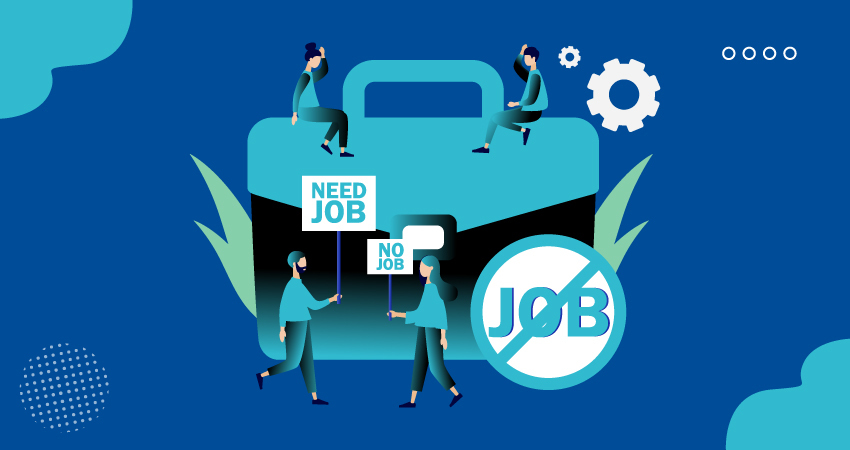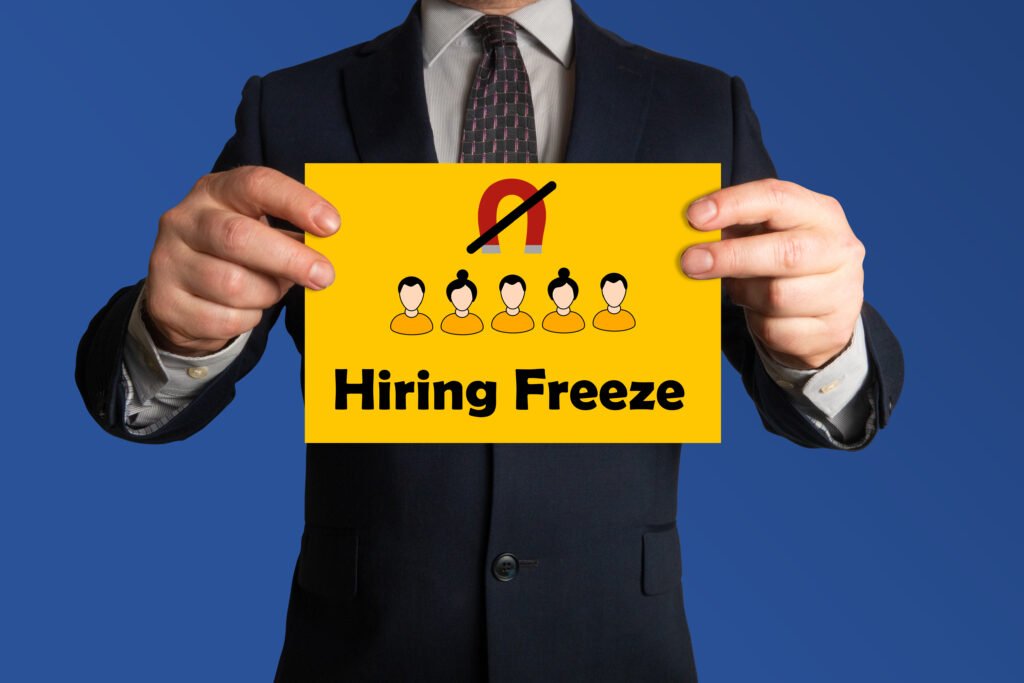
In response to economic downturns or other financial pressures, many organizations may choose to implement a hiring freeze. During a hiring freeze, existing employees may be asked to take on additional responsibilities to make up for the lack of new hires. In some cases, employees may also be offered incentives to retire or resign in order to reduce headcount and save costs. But first,
What is Hiring Freeze?
Hiring freeze means a temporary policy that prohibits the hiring of new employees, either entirely or for specific departments or positions. Hiring freezes can be a difficult but necessary decision for organizations facing financial challenges.

Does a hiring freeze mean layoffs?
It’s important to note that a hiring freeze does not necessarily mean that there will be layoffs. A hiring freeze is simply a policy that prohibits the hiring of new employees, but existing employees will typically still keep their jobs. However, it’s possible that a hiring freeze could eventually lead to layoffs. If the organization is unable to recover financially or implement alternative cost-cutting measures, it may ultimately need to reduce headcount. In this case, layoffs may be necessary in order to balance the budget.
How long do hiring freezes last?
The length of a hiring freeze can vary depending on the reason for the freeze and the organization’s financial situation. In some cases, a hiring freeze may only last a few months, while in other cases it may last a year or more.
It’s important for organizations to regularly review the hiring freeze and reassess whether it is still necessary or whether adjustments need to be made. If the situation improves, the organization may choose to lift the hiring freeze earlier than planned.
What are the reasons for a hiring freeze?
Economic downturns or recession
When the economy isn’t doing well, companies may need to tighten their belts and cut back on expenses, which can include putting a freeze on new hires.
Reduction in revenue or funding
If an organization’s budget is tight or they’ve lost a major source of funding, they may need to hold off on bringing on new employees until they have more resources available.
Merger or acquisition
When two companies come together, they may need to reassess their talent needs and figure out how to integrate existing employees before bringing on new ones.
Internal restructuring or reorganization
When an organization is going through a significant change, such as a new leadership team or a major shift in strategy, they may need to take a step back from hiring to figure out how to best move forward.
Cost-cutting initiatives
If an organization is trying to reduce expenses, they may decide that not hiring new employees is one way to do that.
Compliance with government regulations
For example, some companies may need to freeze hiring temporarily in order to conduct an audit or ensure they’re in compliance with labor laws.

Can one still get hired during a hiring freeze?
In general, it’s unlikely that an organization will hire new employees during a hiring freeze. However, there may be exceptions to this rule. For example, an organization may still need to fill critical positions or positions that are key to the organization’s long-term success. In this case, the organization may choose to make exceptions to the hiring freeze in order to fill those positions.
Additionally, some organizations may continue to hire interns or temporary workers during a hiring freeze. This can be a way to bring in additional talent without committing to long-term employment.
It’s important to note that even if an organization is not currently hiring, it’s still a good idea to submit an application and express your interest in working for the organization. That way, when the hiring freeze is lifted or when new positions become available, your application will already be on file and you’ll be in a better position to be considered for the position.
What is the impact of a hiring freeze?
Increased Workload and Burnout
A hiring freeze can result in an increased workload for existing employees, which can lead to burnout and reduced productivity. When there aren’t enough people to do the work, those who are already employed may be asked to take on additional responsibilities, which can quickly become overwhelming.
Difficulty Filling Critical Positions
A hiring freeze can make it difficult to fill critical positions or meet business needs. When companies aren’t hiring, it can be challenging to find the right people with the right skills to fill open roles. This can lead to delays in important projects and initiatives.
Reduced Morale and Job Satisfaction
When people feel like they’re doing more than their fair share of work or they’re not able to grow and develop their skills because there are no new positions available, they may become disengaged and unhappy.
Potential Negative Impact on Reputation
A hiring freeze can have a negative impact on an organization’s reputation, particularly if it’s seen as a signal of financial instability. When people hear that a company isn’t hiring, they may assume the worst and start to question whether the company is doing well financially. This can make it more difficult to attract top talent in the future.
How can organizations avoid the negative impacts of a hiring freeze and emerge stronger once it’s lifted?
A hiring freeze can have negative impacts on an organization, such as increased workload for existing employees and the potential for talent loss due to attrition. However, there are steps that organizations can take to minimize the negative impacts and emerge stronger once the hiring freeze is lifted. Here are some strategies that organizations can use:
- Prioritize employee well-being
During a hiring freeze, it’s important for organizations to prioritize employee well-being and prevent burnout. This can be achieved by providing support resources such as counseling services and flexible work arrangements.
- Focus on employee development
During a hiring freeze, organizations can use the time to focus on employee development and invest in upskilling and reskilling programs. This can help employees develop new skills and prepare for future growth opportunities.
- Reassess talent needs
A hiring freeze can be an opportunity for organizations to reassess their talent needs and develop a more effective talent acquisition strategy. This can include identifying critical skills and developing a plan to fill gaps in the talent pool.
- Improve employer branding
During a hiring freeze, organizations can improve their employer branding by focusing on employee engagement and highlighting their commitment to employee well-being and development. This can help attract and retain top talent once the hiring freeze is lifted.
- Maintain communication
Organizations should maintain regular communication with employees and stakeholders during a hiring freeze. This can help alleviate uncertainty and build trust. Additionally, organizations can communicate their plans for lifting the hiring freeze and resuming hiring once the time is right.
- Consider alternative workforce models
During a hiring freeze, organizations can consider alternative workforce models such as freelance, contract, and gig workers. This can help them fill critical positions while avoiding long-term employment commitments.
- Leverage technology
Organizations can leverage technology to streamline their talent acquisition process and improve efficiency. This can include using automation tools for resume screening and interview scheduling, as well as leveraging virtual communication tools for interviews and onboarding.
By implementing these strategies, organizations can avoid the negative impacts of a hiring freeze and emerge stronger once it’s lifted. They can attract and retain top talent, develop a more effective talent acquisition strategy, and position themselves for growth and success.
Navigating a Hiring Freeze: Staying Positive and Preparing for the Future
While a hiring freeze can be a tough situation for all parties including founders, employees, HR, and job seekers, it’s important to remember that it’s not always a reflection of one’s performance or the job market as a whole. There are many reasons why an organization might implement a hiring freeze, from economic downturns to cost-cutting initiatives.
Although a hiring freeze can help save money in the short term, it can have negative impacts on an organization in the long run, including increased workload, difficulty filling critical positions, reduced morale, and potentially negative impacts on the organization’s reputation.
To avoid these negative impacts, organizations can focus on employee well-being, maintain open communication, and invest in employee development. This can help minimize the negative effects of a hiring freeze and set the organization up for success once the freeze is lifted.
Overall, while a hiring freeze can be a challenging situation, it’s important to stay positive, stay engaged with one’s work, and keep an eye out for new opportunities as they arise.
In the meantime, get yourself locked and loaded with Zappyhire’s AI-powered recruitment automation software!




